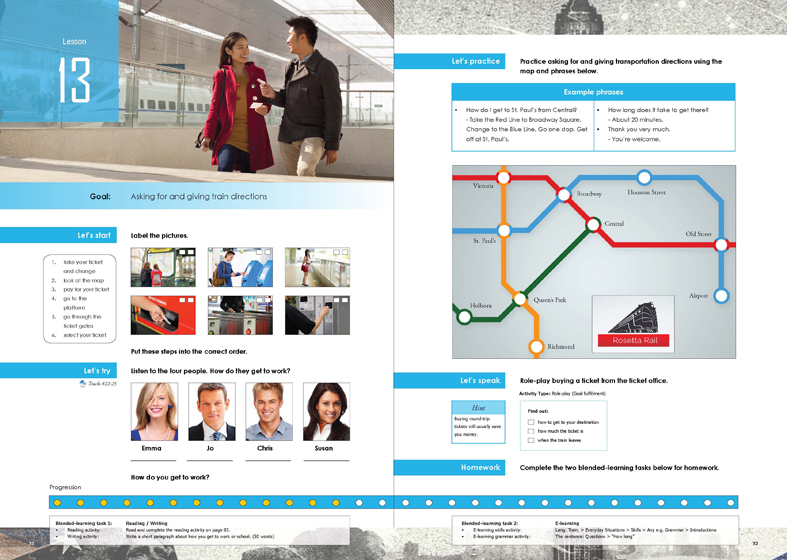
Manuals > General English > Rosetta Stone Advantage > Beginner - Book 1 > Lesson 13
< Previous Lesson | Next Lesson >

By the end of the lesson, the student should be able to ask for and give train directions.
Communication strategies:
The student should be able to able to ask for train directions using the 4 steps below:
1) get the person's attention
2) ask for directions
3) confirm the details
4) thank the person
The student should be able to able to give someone train directions using the 3 steps below:
1) Explain how to get there
2) State how much it will cost
3) State how long the journey takes.
e.g. Take the Yamanote line to Shinjuku, then change to the Takasaki line. Don’t get on the Utsunomiya line. They are both orange. Buy a 180 yen ticket. Omiya will be the 5th stop. It takes about 30 minutes.
Words and rules:
The student should be able to use the imperative mood. e.g. Take the Takasaki line. / Don't take the Keiyo line.
The student should be able to sequence commands. e.g. Then, go straight
Don’t say “you”, when you are giving commands.
“You go straight” = present simple tense (this is used when we talk about facts or habits)
“Go straight” = command (this is used when we tell someone how to do something. It Japanese it may sound a little rude to use commands like this, but in English it’s perfectly fine)
Appropriateness:
Non-verbal behaviour: The student should know how to get someone's attention
Register: Giving directions using the imperative mood is fine if someone asks "how do I" - you don't need to say "please" or "you should"
Social rules: We usually only give 4-5 maximum steps when giving directions. It's common to give a shortcut to start e.g Do you know how to get to XXX? OK, go there, then...
Track #22
Hello, I’m Emma. I work in an office. I start at 9 o’clock and I take the train to work.
Track #23
Hi, I’m Joe. I’m a dentist. I drive to work - it takes about 30
minutes.
Track #24
Hi, my name is Chris. I’m a chef and I work in a big restaurant. I start work at 10 am and I finish at 10 pm. I take the bus to work every day.
Track #25
Hello, my name is Susan. I’m a police officer. I take the subway to work.
Because the lesson touches on the subject of trains, you are welcome to introduce some of the following vocabulary if you like.
1) get on a train (v)
2) take a train (v)
3) switch trains (v)
4) go through the turnstile (v)
5) go into the station (v)
6) go out of the west exit (v)
7) go up the escalator (v)
8) go down the stairs (v)
9) bound for (exp)
10) get off the train at Ueno (v)
Extra activities
Option 1:
Difficulty ★
Type: Picture speculation
Purpose: To test the student’s vocabulary before vocabulary introduction
Method: Have the student look at the six pictures in “Let’s start”. Cover the words in the
vocabulary box and have the student speculate as to what they think is happening in
each picture. Feel free to introduce any vocabulary the student doesn’t know.
Option 2:
Difficulty ★★
Type: Realia presentation
Purpose: Giving authentic directions
Method: Use the directions function of Google Maps, or a similar app to bring up train directions
between two points in Japan. Then have the student tell you how to get from point A to
point B using English and the authentic materials. You can role-play being a lost tourist
if you like.
Option 3:
Difficulty ★★★
Type: Role-play
Purpose: Using walking and train directions together
Method: Ask the student how to get from point A to point B. Make sure that the student gives
you walking or driving directions to the station, then train directions between the two stations, then walking directions to the final destination.
Extra questions you might like to ask in the lesson
- How do I get to… from…?
- What’s the fastest way to get to…?
- What station do I change at?
- How many stops is it?
- Where do I get off?
- How long does it take?
- How much does it cost?
Let’s start
Label the pictures.
Top line (L>R)
Look at the map / select your ticket / go to the platform
Bottom line (L>R)
Take your ticket and change / go through the ticket gates / pay for your ticket
Put the pictures in the correct order.
look at the map
select your ticket
pay for your ticket
take your ticket and change
go through the ticket gates
go to the platform
Let’s try
Listen to the four people. How do they get to work?
Emma = takes the train
Jo = drives
Chris = take the bus
Susan = take the subway
A) How do you get to work?
B) I take the train
Let’s practice
Practice asking for and giving transportation directions using the map and phrases below.
From Richmond to Airport
Take the Yellow Line to St Paul's, then transfer to the Blue Line. Take the Blue Line all the way to the airport. It takes about 10 minutes.
Let’s speak
Role-play buying a ticket from the ticket office.
A) Hello. How do I get to Sydney from here?
B) Take the Central Coast Line. It’s a direct line.
A) How much is one adult one-way ticket?
B) $12.
A) Great. When does the next train leave?
B) The next train leaves in 10 minutes.
A) Thank you.